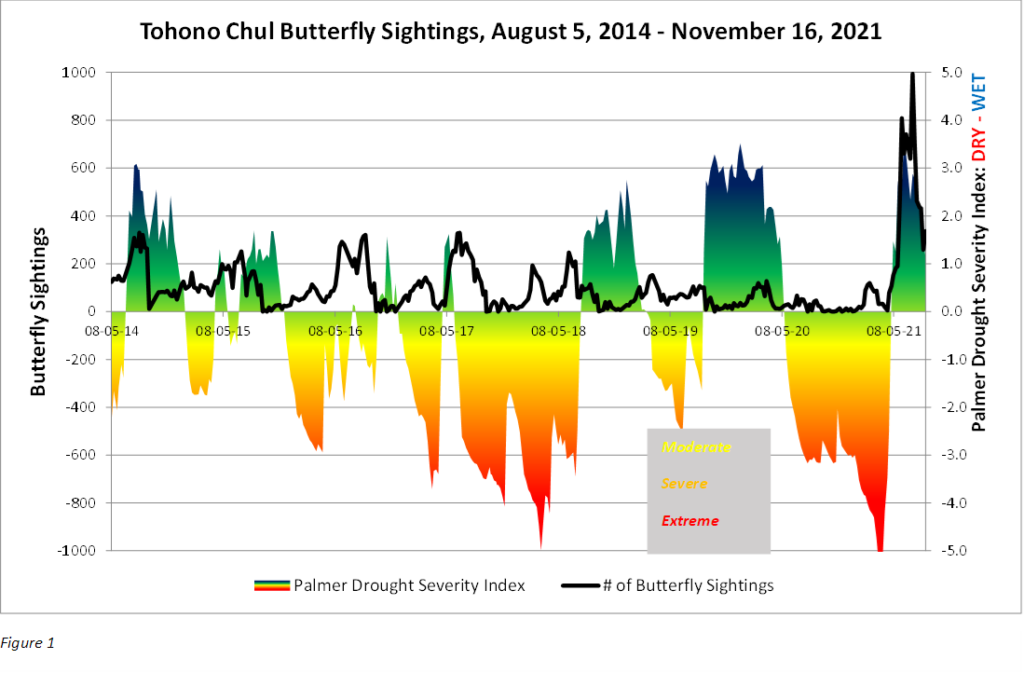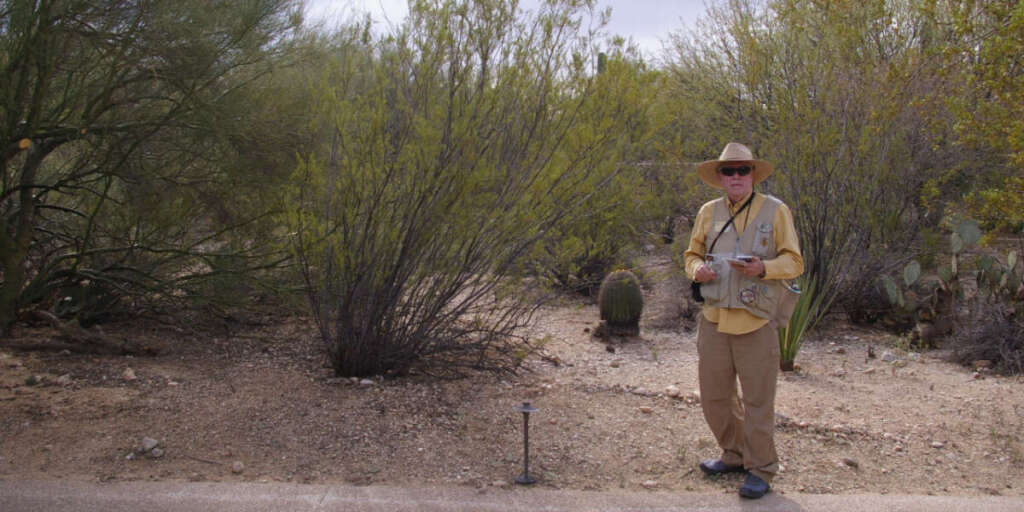
Butterflies, an interview with Andy Hogan
March 3, 2022Stephen Spikes, our Interpretive Programs Manager, sat down with Tohono Chul docent and butterfly enthusiast, Andy Hogan to talk about our butterfly census. Butterfly counts in the summer and fall of 2020 yielded the lowest numbers of butterflies since Andy started logging data in 2014. This also coincided with one of our driest and hottest monsoon seasons on record. Dubbed the 2020 “non-soon” because of the measly 1.6 inches of rain compared to our average 6 inches. The 2021 monsoon, on the other hand, was much wetter than usual with over 12 inches of rain. Butterflies returned in higher numbers than Andy had ever counted before. In their conversation, Andy and Stephen explore why this might be the case and what can be done to help our butterfly populations.
STEPHEN
I noticed an explosion in the numbers of butterflies at Tohono Chul this fall. Was that reflected in your weekly counts?
ANDY
Between mid-August and December 2021, I was setting weekly sighting records for number of butterflies spotted. So, there was a fantastic rebound after our poor summer in 2020. Other butterfly counts that are done in this area by NABA (North American Butterfly Association) saw the same thing. They count in the Catalina mountains, the Rincons, in Patagonia, and in Madera Canyon and witnessed massive rebounds in the number of butterflies. It wasn’t just us at Tohono Chul, everyone was seeing the same things.
STEPHEN
How did the butterfly counts start at Tohono Chul?
ANDY
Well, in the past we didn’t have many docents that knew much about butterflies, or how to lead butterfly tours. So, in 2012, we recruited members of SEABA (Southeast Arizona Butterfly Association) to come here and help us develop a butterfly checklist. And then a year later we started Butterfly tours at Tohono Chul. We had a lot of butterflies and thought somebody should count them. That fell to me, and I started counting in 2014.
STEPHEN
Why is it important to count butterflies?
ANDY
They are pretty good indicators of what is going on in the environment. The numbers really respond if we are in a drought or if it becomes very, very hot. When the local ecosystem is stressed, butterfly numbers go down. And then when things return to normal or better, butterfly numbers can really shoot up very quickly. Butterflies are a sensitive ecological signal like the canary in a coal mine.
STEPHEN
You also use e-Butterfly to record data. Can you tell me a little bit more about that?
ANDY
e-Butterfly is a website where you can add your butterfly sightings to an international database. Researchers use the database as a toolkit to answer different questions related to butterflies and how they are making out in the changing environment. I upload all my counts every week after I do the butterfly tour. e-Butterfly makes my data available to anybody. Docents giving tours can look up what I’ve seen in the last week and know what to expect.
STEPHEN
I noticed from your data that butterfly sightings had been going down until this summer. Do you have any idea why?
ANDY
I think it’s global warming. Mike Crimmins, from the cooperative extension, presented on climate at a volunteer meeting last year. He noted that in terms of precipitation we have had worse droughts than the 2020-2021 drought. But the 2020-2021 drought was a lot hotter. We were breaking temperature records all summer in 2020. Higher temperatures cause everything to lose more water through evapotranspiration. Butterflies have a hard time above 104 degrees, especially if their nectar plants are wilting. You can see this in the data if you look at the two periods where the drought index is very low. The 2016-2018 drought is longer than the 2020-2021 drought, but it wasn’t as severe because the temperatures were lower. And so, the butterflies did better. We don’t see as precipitous of a decline in the data. Tohono Chul was an oasis for butterflies because we care for our gardens. In the 2020-2021 drought, the numbers of days above 104 degrees and the number of days between rain was much higher. That made it a lot harder for plants and butterflies. And you can see our butterfly sightings really dropped in the summer and fall of 2020.

STEPHEN
What can people do to help local butterfly populations?
ANDY
One thing is to support programs that are going to limit global warming. That is good for all of us. Another thing is to plant butterfly gardens with native nectar plants and host plants. They can act as an oasis for butterflies when times get tough.
Butterflies and their Plants tours are given Saturdays and Sundays at 11 a.m. Peak butterfly season is August through October.


